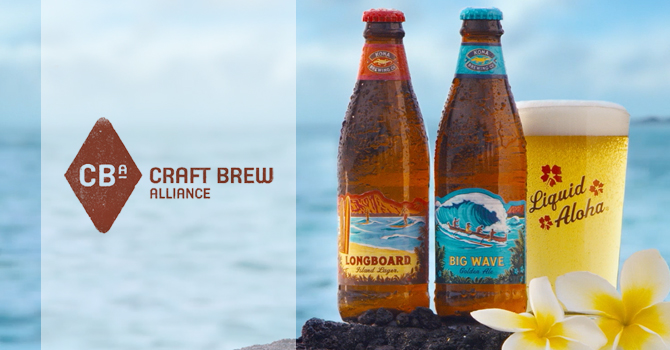
Craft Brew Alliance hopes its marketing efforts in the first part of the year built a “strong foundation” for continued growth throughout the rest of 2019, CEO Andy Thomas said during Thursday’s first quarter earnings call with investors and analysts.
Comparing CBA’s first quarter financial results to a building emerging on a city skyline, Thomas said the groundwork in Q1 — including a $4.6 million advertising spend behind the Kona Brewing brand during the NCAA basketball tournament, and an effort to bolster the brands points of distribution — laid the foundation for the remainder of the year.
He pointed to Kona’s acceleration, the volume gains of CBA’s three acquired craft breweries (Appalachian Mountain Brewery, Cisco Brewers and Wynwood Brewing), and the potential of Omission Ultimate Light, Wynwood’s La Rubia blonde ale and innovative offerings from the company’s pH Experiment business unit.
“I firmly believe that Q1 witnessed the indisputable existence of a remarkably strong foundation for CBA, evidenced by noticeable strength in business fundamentals, such as core beer revenue per barrel growth and gross margin expansion in both the segment and total company levels,” he said.
As Brewbound reported Wednesday, Kona shipments increased 10 percent during the quarter. However, CBA posted a $7.3 million net income loss, due to the $4.7 million cost associated with settling a class-action lawsuit related to the marketing of Kona beers. CBA also recorded a 4.5 percent decline in depletions, despite a 1.5 percent increase in shipments, to 169,500 barrels.

According to chief marketing officer Ken Kunze, the March Madness media buy helped build awareness with consumers, retailers and wholesalers. He also credited the Anheuser-Busch wholesaler network with securing new points of distribution for Kona beer.
“We anticipate our spend will ultimately prove to be an investment in the truest sense of the word,” Thomas added. “Spend today that will payback for multiple periods to come.”
According to Thomas, CBA is “emboldened” by the results of the marketing spend and the prospects for the rest of 2019.
First quarter domestic depletions (sales-to-retailers) for Kona increased 5 percent, with Big Wave Golden Ale depletions growing 19 percent. In April, Kona depletions increased 16 percent, while Big Wave Golden Ale depletions grew 37 percent.
Points of distribution for Kona’s top two brands — Big Wave Golden Ale and Longboard Island Lager — increased a combined 25 percent through April, Kunze added. Through the summer, CBA will attempt to sustain the momentum behind Kona via incremental distribution growth and increased velocity at existing retail accounts.

Also helping boost CBA’s performance during the quarter were the AMB, Cisco and Wynwood brands — which combined depletions increased 13 percent. Kunze also highlighted double-digit depletions growth for flagship brands Wynwood La Rubia (+54 percent), AMB Long Leaf IPA (+38 percent) and Cisco Gripah IPA (+19 percent).
Although Thomas said the company has no immediate plans to distribute beers from those three breweries nationally, the company does see potential to expand the La Rubia brand outside of Florida in an effort to appeal to Hispanic, Caribbean and Latin consumers.
“That’s why we’re launching in Puerto Rico, and that’s why you’ll be hearing more on these calls of where does La Rubia go next?” Thomas said.

Asked about innovation platform the pH Experiment, Thomas called Pacer — a 2 percent ABV, 50 calorie, zero sugar hard seltzer brand aimed at consumers moderating their alcohol intake — “one of the most innovative” alcoholic beverages coming to market.
“It’s remarkable the herd mentality at play right now,” Thomas said. “Everybody is piling atop of each other with these 5 percent [ABV] hard seltzers and hoping that the color of their graphics or the flavor profile or the strength of their wholesaler distribution is going to differentiate them. We’re trying to take a bit of a different tact [with Pacer].”
Elsewhere in the CBA portfolio, Omission Ultimate Light depletions increased 17 percent in Q1. But overall Omission depletions declined 10 percent due to other SKUs losing distribution, Kunze said. The company is in the process of reshaping the Omission portfolio into a “better-for-you” brand, and it plans to launch an Omission hard seltzer line, which will check in at 99 calories, zero carbs and 4 percent ABV.

As for CBA’s legacy brands, Redhook trends improved in its home state of Washington, as depletions for Big Ballard IPA increased 64 percent. Nevertheless, Redhook’s overall depletions declined 23 percent, and dipped 3.5 percent in Washington. Kunze attributed the losses to the fact that 40 percent of Redhook’s volume still resides in small pockets outside of the Pacific Northwest.
Meanwhile, Widmer Brothers depletions declined 12 percent in Oregon and 17 percent overall during the quarter, which Thomas said performed as expected.
In regards to the class-action lawsuit settlement, chief operating officer Scott Mennen said CBA decided to “avoid prolonged legal battles and the associated legal costs.” A judge will consider the settlement during a June 13 hearing.
Thomas once again acknowledged the potential that Anheuser-Busch, which owns a 31.3 percent stake in CBA, could make a qualified offer to buy the company or pay a $20 million fee, noting that there are fewer than 110 days before the August 23 deadline.
In the absence of an offer, Thomas said “CBA’s shareholders can be assured that CBA is well-protected and well-positioned with the security that existing ABI agreements” are in place for up to seven years. He added that CBA would also be able “to embrace a host of strategic alternatives.”
